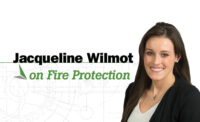Have you ever wondered if the water in your fire-sprinkler system is capable of flowing backward into the water supply it came from? And, if it did, how might it impact the water supply?
If you have ever seen the water that comes out of a sprinkler system, these questions have most certainly crossed your mind, but fear not! The water we use in our day-to-day lives is not impacted by the water inside fire-sprinkler systems.
Fire-sprinkler systems are unique because the water inside the pipes is static. This discolored, thick and smelly sludge, commonly referred to as “black water,” sits over an extended period of time and generally remains dormant until the system is activated in the event of a fire. It’s also the last thing anyone would want to see go into a potable water supply.
The good news is the purpose of a backflow preventer is to protect the potable water supply line from possible contamination or pollution from the fire system, backpressure from fire line-booster pumps or the stagnant water that sits in the fire lines.
Technically, a backflow-prevention device is defined in NFPA 25, Standard for the Inspection Testing and Maintenance of Water Based Sprinkler Systems, as a device used to prevent water in a fire-protection system from entering the public water supply due to a reverse flow of water, thermal expansion, hydraulic shock, back pressure or back siphonage.
Back pressure occurs when the pressure in the downstream piping is greater than the supply pressure of the system and could cause a reverse flow of water, which could be caused from thermal expansion, pump systems or elevated tanks, just to name a few. Back siphonage occurs when there is a drop in pressure on the supply side, such as a water-main break, and this could cause the flow of water in the sprinkler system to reverse as well.
There are two types of backflow-prevention devices: reduced-pressure preventer (RP) type and double-check (DC) type. Both types are required to be listed as complete assemblies that include shutoff valves and test cocks at each end of the apparatus.
One of the most frequently asked questions in the advisory service program on NFPA 13, Standard for the Installation of Sprinkler Systems, is what section requires backflow-prevention devices? NFPA 13 does not require backflow-prevention devices for fire-protection purposes. However, it does state that where backflow devices are installed, a means be included downstream to regularly flow-test the devices per NFPA 25. Once installed, NFPA 25 provides the minimum requirements for inspection, testing and maintenance.
So if NFPA does not require backflow-prevention devices for fire-sprinkler systems, who does?
Municipal water companies typically require backflow-prevention devices on fire systems connected to both public and private potable water sources. Each local authority has its own requirements for the type of backflow assemblies to use and how they are to be installed. Backflow-prevention devices (also known as backflow assemblies when installed with valve trim) need to be listed because these devices are evaluated in the listing for durability, reliability and flow characteristics.
NFPA 25 outlines the inspection, testing and maintenance program for backflow-prevention assemblies. Specifically, Table 13.1.1.2 provides a summary of valves, valve components and trim inspection, testing and maintenance. In this table, backflow-prevention assemblies are required to be inspected weekly in accordance with Section 13.7.1. The purpose of the inspection is to ensure the differential-sensing valve relief port is not continuously discharging. In addition, an internal inspection on the backflow-prevention assemblies is required every five years to verify all components operate correctly, move freely and are in good condition.
Backflow-prevention assemblies are required to be tested annually in accordance with Section 13.7.2 by conducting a forward flow test at a minimum flow rate of the system demand. Once the test or any other repairs are made, an inspection by the property owner or designated representative is required to confirm the system is in service, and that all isolation valves are in the normal open position and properly locked or electrically supervised.
Lastly, NFPA 25 requires the maintenance of all backflow-prevention assemblies to be conducted by a qualified individual following the manufacturer’s instructions in accordance with the procedures and policies of the authority having jurisdiction. The term “qualified” is defined in NFPA 25 as a competent and capable person who has met the requirements and training for a given field acceptable to the AHJ.
So while there are concerns about the stagnant water in fire-sprinkler systems, backflow-prevention devices ensure the water from the sprinkler system cannot flow back into the water supply. Check with your AHJ to determine the requirements for backflow-prevention devices in your jurisdiction.
For additional information on the inspection, testing and maintenance of these devices, please visit www.nfpa.org/25.



